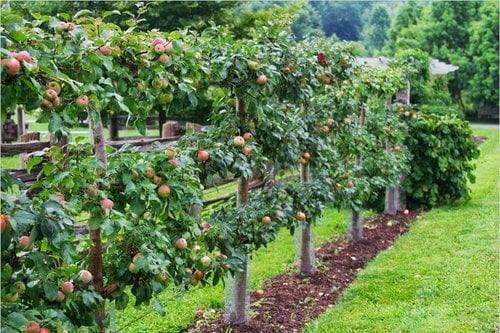 One of my favorite past times is going apple picking at one of the many Rhode Island orchards. I can remember being so shocked by the varieties grown here in Rhode Island. “What? There’s more than just McIntosh, Granny Smith, Fuji, Gala, and Honey Crisp?!” Our economy favors monocultures and of the thousands of varieties which exist, only about 5 different types of apples can be found in most grocery stores. This lack of biodiversity makes plants more susceptible to disease, fungus, and bugs. Thus, most small scale orchards host a much larger variety of species both for economic and environmental reasons. If you have visited local orchards and ever wondered if you could grow apples in your own backyard, then we have a few tips and tricks which should help your venture be fruitful.
One of my favorite past times is going apple picking at one of the many Rhode Island orchards. I can remember being so shocked by the varieties grown here in Rhode Island. “What? There’s more than just McIntosh, Granny Smith, Fuji, Gala, and Honey Crisp?!” Our economy favors monocultures and of the thousands of varieties which exist, only about 5 different types of apples can be found in most grocery stores. This lack of biodiversity makes plants more susceptible to disease, fungus, and bugs. Thus, most small scale orchards host a much larger variety of species both for economic and environmental reasons. If you have visited local orchards and ever wondered if you could grow apples in your own backyard, then we have a few tips and tricks which should help your venture be fruitful.
1. You don’t need an orchard!
Apple trees do not necessarily require acres to grow. Dwarf apple trees need as little as 4-8 ft and other full size varieties require about 15-20 ft. Dwarf apple trees lend themselves well to creating a practical hedgerow when grown flat against a lattice or even an existing fence, this is called an espalier. A note here that dwarf varieties are notorious for uprooting and actually need a sturdy something to support them. Just imagine, you could add a tasty and sightly natural fence in your yard!
3. Organic is hard, but worth it.
According to The Farmer’s Almanac, “many gardeners who swear off pesticides find they need to find, at minimum, an acceptable annual spray treatment for a decent crop.” As mentioned, pollination is an important part of our love affair with apples. Spraying apple blossoms with pesticides while relying on bees to grow said apples is both cruel and unusual. Although apples can be prone to disease, fungus, and pests, it is worth using the many tried and true natural methods to grow your fruit. It’s not only better for you and your neighbors but makes a remarkable difference in the health of our environment. To quote my 2 year old daughters favorite book, Bee and Me by Elle J. McGuiness:
“if it weren’t for us bees, why the plants would be gone. No more peaches. No cherries. No trees to climb on. There’d be no more apples, no flowers to smell. Still, you humans decide you don’t like us that well.”



